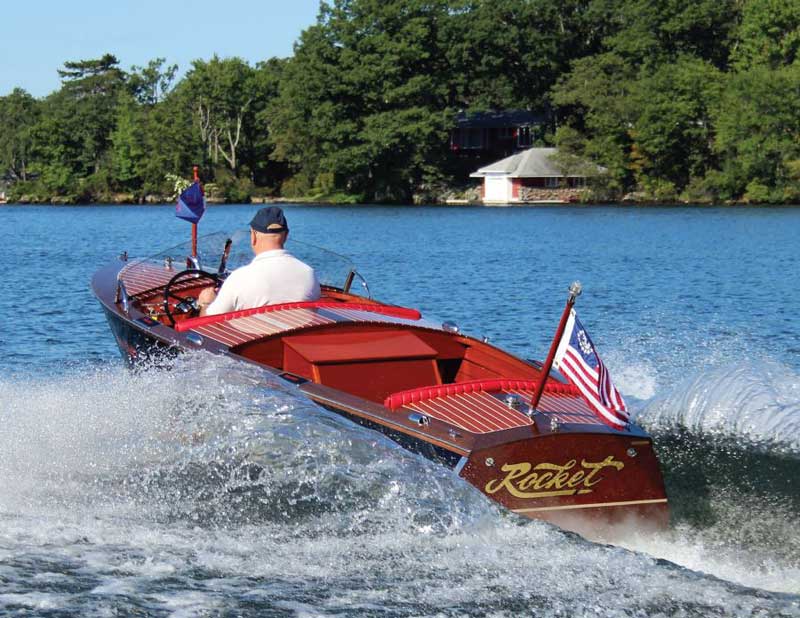The Chris-Craft Rocket is a contemporary classic, custom-built in 2009 to Chris-Craft’s 1951 plans. Both her hull and deck are a symmetry of curves, with lines that flow like any well-designed runabout.

Her black hull and gold leaf work—coupled with the bright-finished deck and transom—sparkle in the sun and make a serious statement. Twelve coats of sprayed clear varnish give the woodwork a depth of shine that is richer than a Steinway grand piano. The multiple coats of black PPG paint over the MAS epoxy wooden hull sides really make the boat stand out on the water. Last but not least, the bronze bottom paint nicely completes her ability to make a great impression.
Back in the day, A.W. MacKerer was the main designer at Chris-Craft. He had studied and/or worked under John L. Hacker, George Crouch, and Gil Purdy.
While history does not tell us how much of this convex hull was created by A.W.’s post-war team, we do know that the plans in 1951 called for a different shape below water than a previously built, planked 16-foot hull. With his team, A.W. developed plans and kit boats so people could build this runabout as well as a selection of other Chris-Craft models.
The 16-foot hull was based on a prior model that was in production between 1946-1949. It measured 16 feet and two inches by five feet and eight inches and weighed 1620 pounds. Chris-Craft built 1040 of these during that four-year production run and called some the Rocket series.
She rides sweetly. Pops up on plane. Handles a chop and wakes like a 16-foot champ that is a 1.5-ton displacement boat. Pounds under chop are minimal due to the convex Chris-Craft hull shape. She steers well and holds a course with ease, without pulling to port or starboard. And she rides level with a small bow up. Attitude!
Three critical adjustments were responsible for that great ride and easy handling, all related to the rudder. Doug, this boat’s owner, researched all the available information in rudder design, expanding on his own experience in engineering. He ultimately reshaped, resized, and rebalanced it (fore and aft to the rudder’s shaft). So, Doug dropped the original rudder, made the changes himself, and remounted it. No additional work required. Voilà. One sweet ride!
Doug became such an expert on classic inboard powered runabouts and displacement rudders that he gave several talks on this topic across the United States, including presentations to several Antique and Classic Boat Society (ACBS) chapters as well as at their annual meeting. His best attended event was for the Lake Tahoe ACBS chapter, which attracted an audience of 90 people eager to learn more.
Van Ness Engineering in Ridgewood, NJ, did the engine. It’s a Grey Maine Fireball 162, fully internally balanced and restored. It is rated at 90 HP if stock. Van Ness took it to 100 HP via an upgraded camshaft. It’s rated to run Wide Open Throttle (WOT) at 4500 revolutions per minute. At 2800 rpms, 25 mph is achieved. The engine is detailed to look like an original engine and shines when the engine box is opened.
The red upholstery is a thickly padded tuck-and-roll design. The roll pattern’s spacing matches the spacing of the white striping in the deck planking. A wide roll pattern spacing down the middle just like the planking really makes it custom to the boat. There are two full width seats in this two-cockpit runabout.
She is a classic design with the mounted engine inboard at the center of the boat. Part of the center deck removes with the engine box to give excellent access to the engine. Her dash has a period-correct fireball grey marine gauge panel for engine instrumentation. Traditional switch gear adds to the classic period-correct feeling.
Switches for the modern safety features are hidden from sight. Doug has installed modern safety items such as the Fume Alert, halon automatic fire extinguisher, and automatic bilge pump. She is a 12-volt boat.
She was built in Pennsylvania by James Craft, which bought the rights to reproduce the boat models originally available in the Chris-Craft Kit Boats catalog. You can typically see boats like this at the Chesapeake Bay Chapter’s Antique and Classic Boat Festival, which was recently canceled. Learn more about ACBS at acbs.org.
By Chris "Seabuddy" Brown